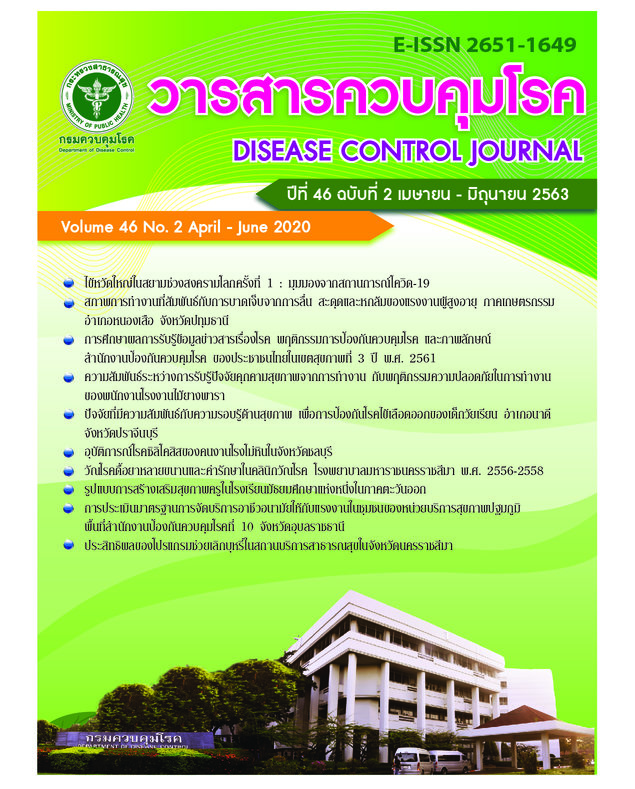Factors related to health literacy for prevention of dengue hemorrhagic fever of school age children in Nadee District, Prachin Buri Province
DOI:
https://doi.org/10.14456/dcj.2020.15Keywords:
Health literacy, school age students, dengue hemorrhagic feverAbstract
This study is a descriptive study research. The research aimed to investigate the re-lationship between self-efficacy, social supporting information about dengue hemorrhagic fever and health literacy. The study subjects were 320 school-age children in Nadee district, Prachin Buri province. All data were collected using questionnaires. These descriptive data were analyzed by descriptive statistics. Analysis of the relationship was carried out by Pearson’s correlation coefficient test. Results revealed that most of the samples were fe-male at 56.2 percent and the average age was 11.0 years old. The majority of them were found to have an inadequate level of health literacy at 53.8 percent, and limited level of literacy at 33.1 percent. Moreover, a correlation study revealed that self-efficacy and social supporting information about dengue hemorrhagic fever were significantly associated with health literacy (r= 0.269, p< 0.001 and r= 0.420, p<0.001, respectively) A learning process for the development of health literacy for the purposes of preventing dengue hemorrhagic fever among school-age children should take into consideration self-efficacy and support-ing information.
Downloads
References
Limkittikul K, Brett J, L’Azou M. Epidemiological trends of dengue disease in Thailand (2000-2011): a systematic literature review. PLoS Negl Trop Dis 2014;8:1-10.
Sailugkum S, Kaewhanam J, Kunpakdee P, Laknamthiang S. The sensitivity of Aedes aegypti larvae to the concentrarion of Temephos 0.02 mg/L Loei and Nongbualumphu Province, 2014. Office for Disease Prevention and Control Region 7, Khon Khaen Journal 2016;2:38-45. (in Thai)
Bureau of Vector-borne Diseases. Report on situation of dengue fever in 2018 [Internet]. 2019 [cited 2019 Mar 14]. Available from: https://drive.google.com/drive/folders/1XpnjMYow-79V0GJtACBnZxa7sSnB0xaV (in Thai)
Bureau of Epidemiology. Annual diseases situation report, number of cases by age group and province, 2018 [Internet]. 2019 [cite 2019 Mar 14]. Available from: http://www.boe.moph.go.th/boedb/surdata/disease.php?dcontent=old&ds=262766 (in Thai)
Nadee Hospital. Report on a total number of cases of dengue fever (26, 27, 66), Nadee District Hospital from 1 January - 31 December 2018. Prachinburi: Nadee Hospital; 2018. (in Thai)
Department of Health Service Support. Strategy for promotion of health literacy and health behaviors. Nonthaburi: Department of Health Service Support; 2018. (in Thai)
Berkman ND, Sheridan SL, Donahue KE, Halpern DJ, Crotty K. Low health literacy and health outcomes: an updated systematic review. Ann Intern Med 2011;155:97-107.
Khumthong T, Potisiri W, Kaewdumkoeng K. Factors influencing health literacy for people at risk of diabete mellitus and hypertension of Uthai Thani and Ang Thong. Veridian E-Journal, Science and Technology Silpakorn University 2016;6:67-85. (in Thai)
Ghaddar SF, Valerio MA, Garcia CM, Hansen L. Adolescent health literacy: the importance of incredible sources for online health Information. J Sch Health 2012;82:28-36.
Bandura A. Social foundation of thought and action: a social cognitive theory. New Jersey: Prentice-Hall; 1986.
World Health Organization. Health literacy the solid fact. Copenhagen: The Regional Office for Europe of the World Health Organization; 2013.
Krejcie RV, Morgan DW. Determining sample size for research activities. Educ Psycho Meas 1970;30:607-10.
Ghanbari S, Ramezankhani A, Montazeri A, Mehrabi Y. Health literacy measure for adolescents (HELMA): development and psychometric properties. PLoS One 2016;11:1-12.
Sawatdirak A, Jaisanit P, Rattanasimakul K, Rattanachoowong S. Development of learning package promotion media literacy of students in educational opportunity schools under Chiang Mai Primary Educational Service Area Office 3. Journal of Social Academic 2016;9:122-38. (in Thai)
Lalley JP, Miller RH. The learning pyramid: does it point teacher in the right direction? Education 2007;128:64-79.
Deemarn W. The countries where students are reluctant to ask teacher in class, and No. 6 ranking for Thai students [Internet]. 2012 [cited 2019 Jun 6]. Available from: https://www.gotoknow.org/posts/493702 (in Thai)
Prochaska JO, Velicer WF. The transtheoretical model of health behavior change. Am J Health Promot 1997;12:38-48.
Lee JY, Divaris K, Baker AD, Rozier RG, Vann WF Jr. The relationship of oral health literacy and self-efficacy with oral health status and dental neglect. Am J Public Health 2012;102:923-9.
Kaewdamkoeng K. Health literacy: access, understanding, and application. Bangkok: Amarin printing & publishing; 2018. (in Thai)
Nateemahakun T, Sarayuthpitak J. Effects of school health program to prevent dengue hemorrhagic fever disease of elementary school students. Online Journal of education 2014;9:209-21. (in Thai)
Downloads
Published
How to Cite
Issue
Section
License
Articles published in the Disease Control Journal are considered as academic work, research or analysis of the personal opinion of the authors, not the opinion of the Thailand Department of Disease Control or editorial team. The authors must be responsible for their articles.






